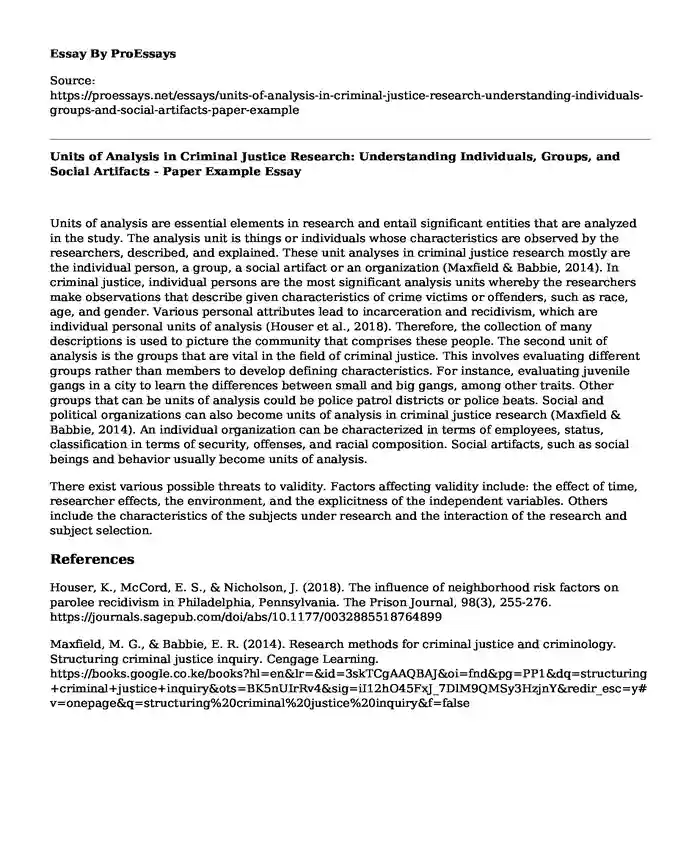Units of analysis are essential elements in research and entail significant entities that are analyzed in the study. The analysis unit is things or individuals whose characteristics are observed by the researchers, described, and explained. These unit analyses in criminal justice research mostly are the individual person, a group, a social artifact or an organization (Maxfield & Babbie, 2014). In criminal justice, individual persons are the most significant analysis units whereby the researchers make observations that describe given characteristics of crime victims or offenders, such as race, age, and gender. Various personal attributes lead to incarceration and recidivism, which are individual personal units of analysis (Houser et al., 2018). Therefore, the collection of many descriptions is used to picture the community that comprises these people. The second unit of analysis is the groups that are vital in the field of criminal justice. This involves evaluating different groups rather than members to develop defining characteristics. For instance, evaluating juvenile gangs in a city to learn the differences between small and big gangs, among other traits. Other groups that can be units of analysis could be police patrol districts or police beats. Social and political organizations can also become units of analysis in criminal justice research (Maxfield & Babbie, 2014). An individual organization can be characterized in terms of employees, status, classification in terms of security, offenses, and racial composition. Social artifacts, such as social beings and behavior usually become units of analysis.
There exist various possible threats to validity. Factors affecting validity include: the effect of time, researcher effects, the environment, and the explicitness of the independent variables. Others include the characteristics of the subjects under research and the interaction of the research and subject selection.
References
Houser, K., McCord, E. S., & Nicholson, J. (2018). The influence of neighborhood risk factors on parolee recidivism in Philadelphia, Pennsylvania. The Prison Journal, 98(3), 255-276. https://journals.sagepub.com/doi/abs/10.1177/0032885518764899
Maxfield, M. G., & Babbie, E. R. (2014). Research methods for criminal justice and criminology. Structuring criminal justice inquiry. Cengage Learning. https://books.google.co.ke/books?hl=en&lr=&id=3skTCgAAQBAJ&oi=fnd&pg=PP1&dq=structuring+criminal+justice+inquiry&ots=BK5nUIrRv4&sig=iI12hO45FxJ_7DlM9QMSy3HzjnY&redir_esc=y#v=onepage&q=structuring%20criminal%20justice%20inquiry&f=false
Cite this page
Units of Analysis in Criminal Justice Research: Understanding Individuals, Groups, and Social Artifacts - Paper Example. (2023, Dec 13). Retrieved from https://proessays.net/essays/units-of-analysis-in-criminal-justice-research-understanding-individuals-groups-and-social-artifacts-paper-example
If you are the original author of this essay and no longer wish to have it published on the ProEssays website, please click below to request its removal:
- Should Private Security Personnel Have a Stronger Background in Business or Criminal Justice?
- Development of Intellectual Property in the World Essay
- Introducing an Enhanced Gynecology Service in Primary Healthcare Facilities in the UAE
- Research Paper on African American Males and Capital Punishment
- Essay Sample on Autonomous Weapons Ban
- Imprisonment: Ancient Times to Modern Day - Essay Sample
- Man Found Dead: 3 Suspected Scenarios, 2 Likely Causes - Essay Sample







